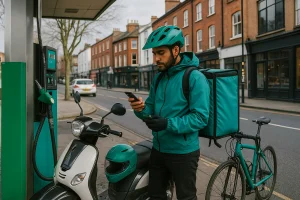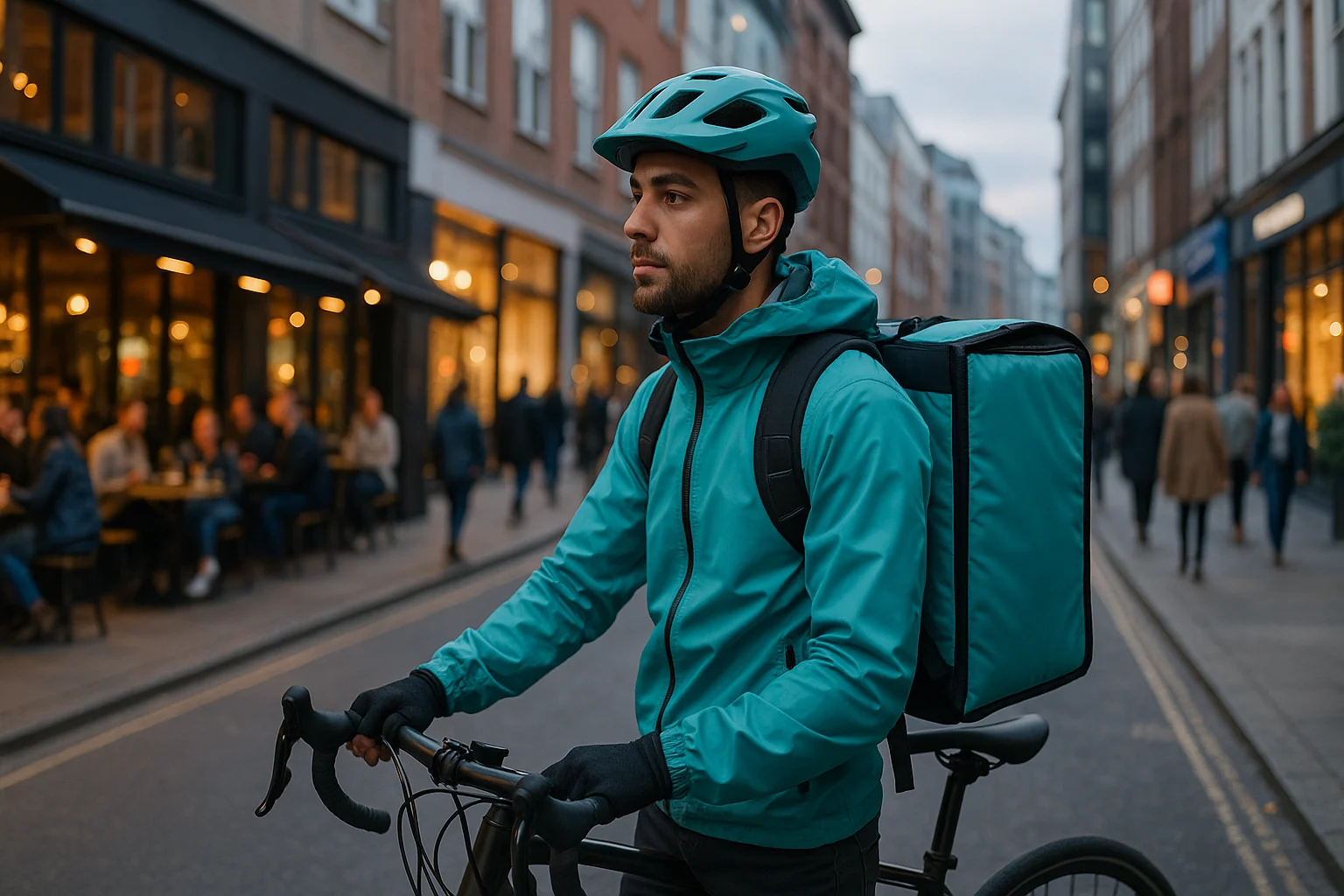Is working as a Deliveroo driver in the UK a financially sustainable job? What kind of income can one expect in 2025, and what are the variables that affect earnings? These are common questions for those considering food delivery as a full-time career or flexible side hustle.
The gig economy has created opportunities for individuals seeking independence and control over their working hours. Deliveroo, one of the most prominent food delivery platforms in the UK, has drawn attention for its promise of flexibility and attractive hourly rates. But the key concern remains: how much does a Deliveroo driver actually earn, and what factors influence that income?
This blog provides a detailed, updated overview of Deliveroo driver pay in the UK, breaking down everything from delivery fees and tips to working conditions and hidden costs.
What Is the Current Average Pay for Deliveroo Drivers in the UK?

In 2025, Deliveroo drivers typically earn between £14 and £15 per hour on average, although this rate can fluctuate depending on various external conditions. Those who work in larger urban centres such as London, Birmingham, or Manchester often report higher hourly earnings, sometimes reaching up to £18 per hour during busy periods or when operating efficiently.
These figures represent gross earnings, meaning they are calculated before deducting expenses like fuel, bike maintenance, and taxes. The more experienced and strategically minded a rider is, the greater their ability to improve their hourly income.
For example, a rider who targets peak lunch and dinner hours and knows the most efficient routes is likely to complete more deliveries per hour, increasing their potential earnings.
How Does Deliveroo Calculate Driver Pay?
Deliveroo operates on a per-delivery payment system. This means riders are not paid hourly but instead receive a fee for each completed delivery. The delivery fee can vary significantly and is influenced by multiple factors, including the distance between restaurant and customer, current demand, estimated time, and traffic conditions.
A typical delivery fee ranges from £2.90 to £6, but some longer or more complex deliveries may exceed that range. One major advantage of Deliveroo’s system is that riders are shown the delivery fee before they accept a job, giving them full visibility over what they will earn per trip.
Additionally, riders retain 100% of any tips provided by customers. These tips can be given through the app or in cash. App-based tips are added to the rider’s weekly earnings, or they can be withdrawn sooner through Deliveroo’s “Cash Out” feature for a small fee of £0.50.
The platform also allows riders to stack deliveries – that is, pick up multiple orders from the same restaurant and deliver them to different customers located along the same route. These types of deliveries often improve earnings efficiency, allowing riders to complete two or more deliveries in the time it would usually take to do one.
What Affects the Amount a Deliveroo Rider Can Earn?

Deliveroo driver earnings can vary widely depending on several important factors. These variables often have a significant impact on both the number of deliveries completed per hour and the overall income potential.
Location is one of the most important variables. Riders in city centres or busy urban areas usually benefit from a higher volume of orders and shorter travel distances between pickups and drop-offs. In contrast, those working in smaller towns or rural areas may experience fewer deliveries and longer distances between jobs, which can reduce hourly income.
Another critical factor is the time of day. Deliveroo experiences peak order volumes during lunch (12 PM – 2 PM) and dinner (5 PM – 9 PM). Drivers who schedule their work during these periods are more likely to receive back-to-back orders, maximising their income. On weekends and public holidays, demand can be even higher, particularly during poor weather when more customers prefer home delivery.
The vehicle type also influences earnings. Cyclists often benefit in urban areas due to easier navigation and no fuel costs, while motor vehicle riders may complete deliveries more quickly over longer distances but face additional expenses like fuel, parking, and insurance.
Lastly, a rider’s efficiency and experience play a role. Those who know the local area well, avoid unnecessary waiting times at restaurants, and maintain a high order acceptance rate tend to earn more consistently.
How and When Do Deliveroo Riders Get Paid?
Deliveroo’s payment system is straightforward. Riders are paid every Tuesday, with funds transferred directly to their bank accounts. The weekly payout includes the per-delivery fees and any tips earned during that period.
For those who need faster access to their earnings, Deliveroo offers an instant cash out feature within its app. For a small fee of £0.50, riders can withdraw their available balance at any time.
The Deliveroo app provides a detailed breakdown of:
- Deliveries completed
- Fees earned per delivery
- Total tips received
- Weekly and daily income summaries
This level of transparency helps riders keep track of their income and identify the most profitable times and zones to work.
Is It Possible to Work Full-Time for Deliveroo or Is It Just a Side Gig?
Deliveroo offers a level of flexibility that suits a wide range of working arrangements. Some people choose to work part-time to supplement their primary income, while others treat it as a full-time role.
Below is a breakdown of potential earnings based on hours worked:
| Work Type | Weekly Hours | Estimated Weekly Income | Estimated Monthly Income |
|---|---|---|---|
| Casual (Student) | 10–15 | £140–£225 | £560–£900 |
| Side Hustle | 20–25 | £280–£375 | £1,120–£1,500 |
| Full-Time | 35–45 | £500–£700+ | £2,000–£2,800+ |
These estimates assume riders are working in areas with consistent order demand and during peak hours.
For full-time riders, especially those in high-density cities, it is possible to make upwards of £2,500 per month with an efficient schedule. However, this income is gross, and actual take-home pay depends on expenses.
What Costs Do Deliveroo Drivers Need to Account For?

Deliveroo riders are self-employed contractors, which means they are responsible for covering their own business expenses. While this model provides greater freedom, it also requires careful financial planning.
Common Expenses:
| Expense Type | Monthly Estimate |
|---|---|
| Fuel (for cars/scooters) | £60–£150 |
| Phone data & maintenance | £10–£30 |
| Vehicle/bike upkeep | £20–£80 |
| Insurance (motor only) | £25–£75 |
| Tax & National Insurance | Varies |
Riders using bicycles may incur fewer costs, but they still need to maintain their equipment and account for phone usage and self-assessment tax payments.
Additionally, since Deliveroo riders are not entitled to employee benefits, they do not receive sick pay, holiday pay, or pension contributions. These are important considerations, especially for those relying on Deliveroo as a primary source of income.
Is Working for Deliveroo a Good Earning Opportunity in 2025?
Deliveroo continues to be a popular option for people seeking flexible and independent work, particularly in the current economic climate. It allows individuals to choose their own hours, work at their own pace, and earn based on their effort and availability.
The ability to maximise income by working during busy periods, accepting high-paying orders, and delivering multiple orders at once adds a performance-based incentive that suits motivated individuals.
However, the unpredictable nature of delivery demand and the absence of guaranteed minimum pay mean it’s not ideal for everyone. New riders should approach the role with realistic expectations and take time to understand their local market before committing full-time.
For many, Deliveroo remains a valuable and viable part-time income source. For those willing to plan their schedule and expenses carefully, it can also serve as a profitable full-time gig.
What Do Real-World Earning Examples Look Like for UK Riders?
The earning potential of a Deliveroo rider in the UK depends on several dynamic factors, but perhaps the clearest way to understand it is by looking at actual scenarios. Below are three fictional yet realistic rider profiles, Sam, Raj, and Brad, who operate in different parts of the UK and approach the job in different ways.
Sam – The Full-Time Rider in London
Sam is a 28-year-old rider based in central London. He works Deliveroo full-time, cycling between busy commercial areas during lunch and dinner rushes. Sam knows the city well, uses the rider app to identify high-demand zones, and often completes multiple deliveries per trip.
He typically works 5 days a week, averaging 40–45 hours.
| Metric | Value |
|---|---|
| Location | London (Zone 1–2) |
| Weekly Hours | 42 |
| Deliveries per Week | 115 |
| Average Tips per Week | £55 |
| Estimated Weekly Earnings | £720 |
| Estimated Monthly Income | £2,800+ |
Raj – The Part-Time Evening Rider in Manchester
Raj is a postgraduate student in Manchester who works evenings and weekends with Deliveroo. He uses an electric scooter, which allows him to move quickly between residential and city-centre zones. Raj targets Friday to Sunday shifts and works a few evenings during the week.
He typically works 20–25 hours per week.
| Metric | Value |
|---|---|
| Location | Manchester |
| Weekly Hours | 22 |
| Deliveries per Week | 60 |
| Average Tips per Week | £25 |
| Estimated Weekly Earnings | £360 |
| Estimated Monthly Income | £1,400–£1,500 |
Brad – The Weekend Side Hustler in Brighton
Brad works a 9–5 job during the week and rides for Deliveroo over the weekend to make extra cash. He uses a bicycle and enjoys the physical activity and flexibility. Brad works mostly Saturday and Sunday, with occasional Friday evenings.
He typically works 10–12 hours per week.
| Metric | Value |
|---|---|
| Location | Brighton |
| Weekly Hours | 11 |
| Deliveries per Week | 30 |
| Average Tips per Week | £12 |
| Estimated Weekly Earnings | £180 |
| Estimated Monthly Income | £700–£750 |
These examples reflect a cross-section of Deliveroo riders with different schedules, locations, and earning goals. While Sam treats Deliveroo as a full-time job, Raj and Brad use it as a part-time or supplemental income source.
FAQs
How are fees calculated for each delivery on Deliveroo?
Fees are based on distance, time, and traffic conditions. The exact delivery fee is shown to the rider before they accept the order.
Do riders keep all their tips?
Yes. Deliveroo riders receive 100% of the tips customers leave via the app, along with any cash tips given in person.
Is Deliveroo a good side hustle for students?
Deliveroo is a popular option among students due to its flexible hours, especially during evenings and weekends.
Are Deliveroo riders self-employed?
Yes. Riders operate as independent contractors, which means they are responsible for managing taxes and business expenses.
Can I use any vehicle to deliver for Deliveroo?
Riders can use a bicycle, scooter, or car, depending on local area requirements and regulations. Motor vehicle users must have the proper insurance.
How frequently does Deliveroo pay its riders?
Payments are made weekly, typically on Tuesdays. Riders can also access earnings early using the cash-out feature.
Is it worth using multiple delivery apps alongside Deliveroo?
Yes. Many riders maximise income by also working with Uber Eats, Just Eat, or Stuart to increase job availability.

